Sold Ceramics
Sold Japanese Blue and White wares 17th Century
Dishes
Page 1
The knowledge and expertise required to make porcelain was already present in Japan as far back as the early 17th century. According to legend a Korean potter discovered clay suitable for making porcelain near Arita on the island of Kyushu in the south of Japan in around 1605. Porcelain made from this clay, called shoki-Imari, was intended for the foreign market and soon acquired a surprisingly characteristic Japanese style of decoration, first with a blue underglaze decoration and later in enamel colours. The experience of the manufacturers with enamel colours turned out to be of great importance later. (source: Groninger Museum, Groningen)
When Japanese potters started to make porcelain. It was inspired by underglaze blue porcelain manufactured in kilns of Southern China. By the mid-17th century, Chinese porcelain went into decline due to social unrest and accompanying dynastic change. Dutch merchants, from their base on the small island of Deshima, near Nagasaki, were permitted to trade with Japan. Responding to European demand, the Dutch encouraged the fledgling Japanese porcelain industry to fill the gap left by China.
The porcelain the Dutch brought to Europe in the 17th century was in most cases consciously designed to cater to western tastes. To ensure that they would find a ready market, the Dutch often made wooden or earthenware models of designs and sent those to Japan to be copied.
Flasks, ewers and large dishes are examples for shapes made for the Dutch. They are painted in underglaze blue or a palette of enamels dominated by red, green and blue with flowers, figures and landscapes which would not follow traditional Japanese aesthetics. Vessels with landscape designs are often inspired by 17th century Chinese Transitional style. Plates decorated with designs organized by panels imitate the successful blue-and-white Chinese Kraak ware. To make these export wares even more attractive for the Dutch clients numbers of early Japanese export wares are painted with a stylized tulip, referring to the tulipomania, the great Dutch craze of the 1630s. (source: Keramiek Museum Princessehof, Leeuwarden)
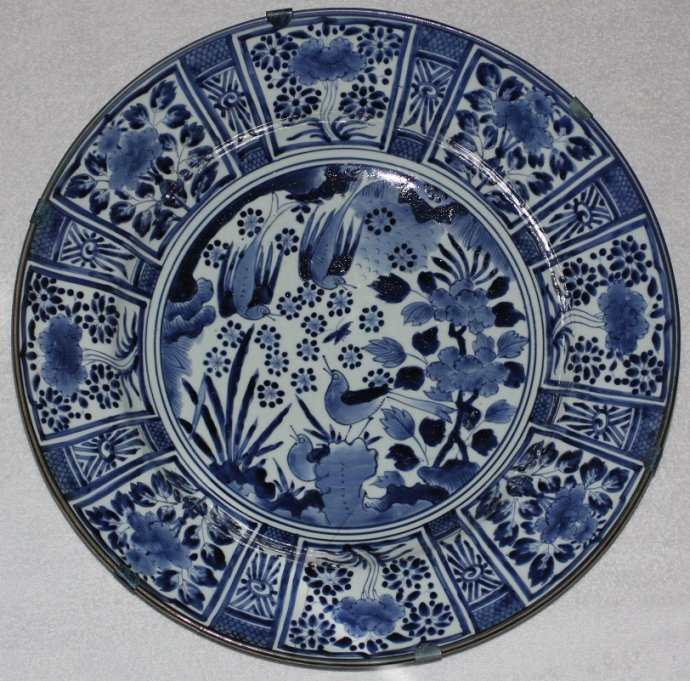
Sold Ceramics - Sold Japanese Blue and White wares 17th Century - Dishes - Page 1
Object 2012051
Large dish
Japan, Arita presumably Sarugawa
1670-1690
Provenance: Collection Clevering, Den Andel.
Height 99 mm (3.90 inch), diameter of rim 548 mm (21.57 inch), diameter of footring 137 mm (5.39 inch), weight ~ 7,800 grams (275.14 ounce (oz.))
Large dish on footring, flat rim. On the base twelve spur-marks. Fitted in a custom-made steel frame. Decorated in underglaze blue with two birds perched on a rock surrounded by various flowering plants observing two other birds in flight. On the sides large panels filled with flowering plants alternating with small panels filled with knotted tassels between a scale pattern ground. On the reverse two stylised peach sprays, a rectangular paper collectors label with the handwritten number: '354' and an old rectangular paper label with the printed text: 'Schoorsteen geveegd door AUG. DELEA - LEEUWARDEN Tel. 8552 - Giro 483138 Eewal 44 hoek Gr. Hoogstr.'
The decoration was copied from Chinese kraak porcelain. This style is characteristic of early Japanese export porcelain made for the Dutch East India Company, (Vereenigde Oost-Indische Compagnie, VOC) to replace the well-known Chinese kraak and Transitional wares. Polychrome versions were made as well. (Jörg 2003/1, p.27)
In October 2016 auction house Omnia Kolham sold an important and interesting collection of Chinese and Japanse export porcelain. It concerned the collection Clevering from Den Andel, a collection mainly formed before the second World War and since then occassionally further expanded.
It was a typical 'Groninger' collection with blue-and-white and coloured export porcelain similar to that shipped to the Netherlands in the 17th and 18th centuries by the Dutch East India Company, (Vereenigde Oost-Indische Compagnie, VOC). 'Groninger' collectors were traditionally more fond of porcelain decorated in enamel colours than on blue-and-white and that preference was also clear in this collection.
Up for auction came a wide range of Chinese, but also Japanese porcelain for the Dutch market. In addition to the ornamental function - even now one can see on the 'Groninger Hogeland' plates and saucers as wall decorations - much of this China is still being used today on special occasions.
An important aspect of such an 'old' collection is the fact that it was collected at a time when export porcelain was not yet being copied. The authenticity of the pieces was thereby guaranteed.
Such comprehensive, classical-wide collections are rare. This collection was a great example of a 'Groninger' tradition of collecting oriental porcelain and how this porcelain was once part of the interior decoration of the 'Groninger' establishment during of the former century.
In 1982 the Groninger Museum organised the exhibition 'Oosterse keramiek uit Groninger kollekties'. Some of the exhibited objects, chosen by Jörg, came from the 'old' Clevering collection. This dish was one of the chosen objects and was published in the exhibitions complimentary catalogue as catalogue number 110.


Reproduced from, Oosterse keramiek uit Groninger kollekties,exhibition catalogue Groninger Museum, (C.J.A. Jörg, Martinipers/Wolters-Noordhoff, Groningen 1982). p.81, cat. 122 (copyright in bibliographic data and cover images is held by the publisher or by their respective licensors: all rights reserved)
Condition: A hairline to the rim.
References:
Lunsingh Scheurleer 1971, cat. 10
Price: Sold.

Sold Ceramics - Sold Japanese Blue and White wares 17th Century - Dishes - Page 1
Object 2011207
Dish
Japan
1660-1680
Height 72 mm (2.83 inch), diameter of rim 450 mm (17.71 inch), diameter of footring 215 mm (8.47 inch)
Large dish on footring, wide everted rim. On the base four spur-marks in a Y-pattern. Decorated in underglaze blue with a flower vase on a terrace, encircled by an eight pointed scalloped medallion. On the sides and rim narrow panels filled with tassels in between a diaper or scale pattern. The large panels are filled with flowering plants, Buddhist good-luck symbols (lantern) or Artemisia leaves. The reverse is undecorated. Marked on the base with a shop-mark, underglaze blue.
The decoration was copied from Chinese kraak porcelain, although, as usual, it is simplified on such imitations. This style is characteristic of early Japanese export porcelain made for the VOC (Dutch East India Company, 1602–1799) to replace the well-known Chinese kraak and Transitional wares. (Jörg 2003/1, p.27) The original Chinese kraak design, please see: object 2011235, apparently appealed to Europeans, various imitations, like this Dutch (Delft), please see: object 2011218 and this Japanese dish were made. Jörg shows three different dishes with this design; the original Chinese kraak version, the Japanese and Dutch Delftware imitations. (Jörg 2011/1, pp.98-99)
For identically decorated dishes, please see:
- Japans porselein met blauwe decoraties uit de tweede helft van de zeventiende en de eerste helft van de achttiende eeuw. (D.F. Lunsingh Scheurleer in Mededelingenblad Nederlandse Vereniging van Vrienden van de Ceramiek, vols. 64/65, 1971), p.55, cat. 10.
- De Japanse Porseleinkast. Japans export porselein uit de 17e en 18e eeuw, exhibition catalogue Museum Willet-Holthuysen, Amsterdam 1972, p.8, cat. nr 4.
- H.A. Daendels, Catalogus tentoonstelling Japans blauw wit Porselein. Op Hollandse bestelling en in de Japanse smaak, exhibition catalogue Gemeentelijk Museum Het Princessehof, Leeuwarden 1981. Also Published as Mededelingenblad Nederlandse Vereniging van Vrienden van de Ceramiek, vols. 101/102, p.23, cat. 4b.
- Japanese porcelain. A collector's guide to general aspects and decorative motifs, (P.L.W. Arts, Uigeversmaatschappij De Tijdstroom, Lochem, 1983), p.38, Plate 9.
- Ooster porselein Delfts Aardewerk Wisselwerkingen, (C.J.A. Jörg, Uitgeverij Kemper, Groningen, 1983. p.54, cat 59.
- Interaction in Ceramics. Oriental porcelain and Delftware. (C.J.A. Jörg, Hong Kong, 1984), pp.104-105, cat. 59.
- Fine & Curious: Japanese Export Porcelain in Dutch Collections, (C.J.A. Jörg, Hotei Publishing, Amsterdam, 2003), p.27, cat. 6.
- Austrumu porcellans un Niderlande. Austrumu un Rietumu mijiedarbiba 17. gadsimta / Oriental Porcelain and the Netherlands. Interaction between East and West in the 17th century, (C.J.A. Jörg, Art Museum Riga Bourse, Riga, 2011), pp.98-99, cat. 18.
Condition: A restored circular firing flaw and chip with a connected V-shaped hairline to the rim.
References:
Lunsingh Scheurleer 1971, cat. 10
Price: Sold.
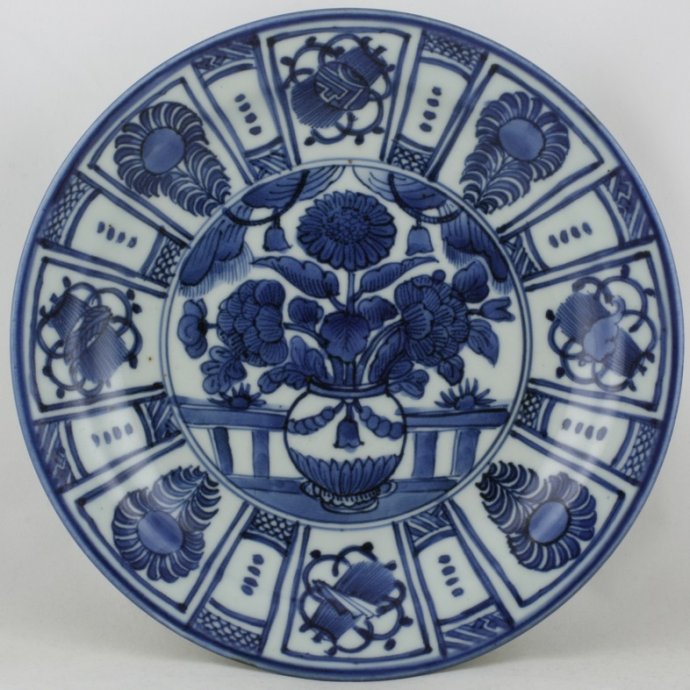
Sold Ceramics - Sold Japanese Blue and White wares 17th Century - Dishes - Page 1
Object 2012246
Dish
Japan
1660-1680
Height 31 mm (1.22 inch), diameter of rim 210 mm (8.27 inch), diameter of footring 111 mm (4.37 inch), weight 318 grams (11.22 ounce (oz.))
Dish on footring, flat rim. On the base four spur-marks. Decorated in underglaze blue with a flowerpot with ribbons and tassels on a fenced terrace filled with flowering chrysanthemum and peony plants under a curtain with ribbons and tassels in a circular cartouche. The sides and rim in Chinese Kraak-style with eight large panels containing peach and auspicious symbols and eight narrow panels filled with a scale pattern and dots. The reverse is undecorated.
Tassels and ribbons are an unusual and rare motif on Arita blue-and-white export ware. In the early 18th century tassels and ribbons can be found on Japon de commande Armorial ware for the Van Buren, Van Buren and Van Brederode and the Van Bambeeck family.
For a similarly decorated dish, without the tassels and ribbons, please see:
Condition: Perfect.
References:
Lunsingh Scheurleer 1971, cat. 10
Jörg 2003/1, pp.232-233 & cat. 6
Price: Sold.

Sold Ceramics - Sold Japanese Blue and White wares 17th Century - Dishes - Page 1
Object 2012258
Dish
Japan
1660-1680
Height 38 mm (1.49 inch), diameter of rim 216 mm (8.50 inch), diameter of footring 108 mm (4.25 inch), weight 440 grams (15.52 ounce (oz.))
Dish on footring, flat rim. On the base four spur-marks in a Y-pattern. Decorated in underglaze blue with a flowerpot filled with flowering peony plants on a fenced terrace in a circular cartouche. The sides and rim in Chinese Kraak-style with six large panels containing a bird perched on a rock flanked by flowering plants and six narrow panels filled with a floret between scrolls on a underglaze blue ground. The reverse is undecorated.
The crackled glaze is caused by the unequal contraction of the body and the glaze during cooling in the kiln after firing. (Jörg & Van Campen 1997, p.235)
Condition: Some firing flaws and fine crazing to the glaze, caused by the firing process.
Reference:
Price: Sold.
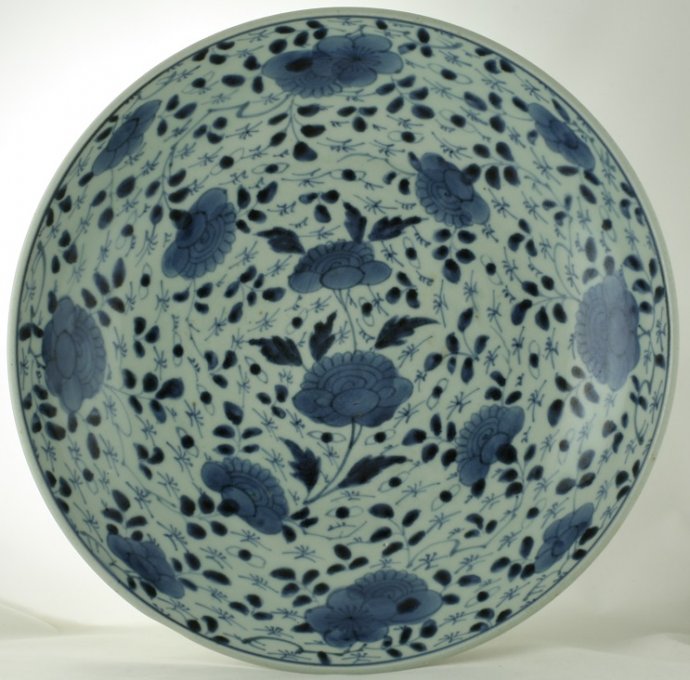
Sold Ceramics - Sold Japanese Blue and White wares 17th Century - Dishes - Page 1
Object 2011507
Dish
Japan
1660-1680
Height 77 mm (3.03 inch), diameter of rim 357 mm (14.05 inch), diameter of footring 190 mm (7.48 inch), weight 2,063 grams (72.77 ounce (oz.))
Dish on footring with a straight rim. On the base five spur-marks in a X-pattern. Decorated in underglaze blue with an overall pattern of flower heads with leafy scrolls. The reverse is undecorated.
Japanese porcelain trade began on 7 October 1656 when the directors of the Dutch East India Company, (Vereenigde Oost-Indische Compagnie, VOC) in Amsterdam decided to ask the High government in Batavia to send an assortment of porcelain to The Netherlands, hoping to profit from what they suspected was a burgeoning market, 'because [we found] that much [was] being brought by many private persons. It was their reaction to several cases of porcelain confiscated from private persons who were apparently able to buy it. The Company succeeded in supplying porcelain to the markets in Asia and The Netherlands for about 20 years. Things changed again in the early 1680's when the Chinese emperor Kangxi (1662-1722) established peace in China. The porcelain factories in Jingdezhen were rebuilt and porcelain exports resumed. The Chinese offered new shapes and decorations, there prices were low and junks distributed porcelain throughout south-east Asia and offered it on the open markets, including Batavia. Specific shapes and decorations, including those in Western style could be ordered as desired. Japanese porcelain producers could no longer compete in this new situation and the last VOC shipment for the Netherlands was sent from Deshima in 1683. Inter Asian trade continued, however, and Japanese porcelain was bought for Batavia, Ceylon, Bengal Persia and other destinations until 1757. (Jörg 2003/1, pp.11-12)
Dishes like these were made for that inter Asian trade and were not meant for export to the West.
Condition: A firing flaw to the rim.
Reference:
Price: Sold.

Sold Ceramics - Sold Japanese Blue and White wares 17th Century - Dishes - Page 1
Object 2011234
Dish
Japan, Arita presumably Sarugawa
1670-1690
Height 38 mm (1.50 inch), diameter of rim 209 mm (8.22 inch), diameter of footring 116 mm (4.57 inch), weight 354 grams (12.49 ounce (oz.))
Dish on footring, flat rim. A spur-mark on the base. Decorated in underglaze blue in the style of Chinese kraak porcelain with an insect perched on a rock in a marsh landscape with water, rocks and flowering plants encircled by an eight pointed scalloped medallion. The sides with eight large panels filled with stylised flowers alternating with various auspicious symbols and eight narrow panels filled with a scale or meander pattern and dots. On the reverse, large panels filled with stylised pearls and dots and narrow panels filled with stylised lingzhi.
The shape and style of this piece were closely copied from a Chinese kraak porcelain dish. The porcelain is heavier and thicker than kraak porcelain, the blue is darker and the body greyer
When the Chinese supply of Oriental porcelain diminished at the end of the 1640s the VOC, (Dutch East India Company, 1602–1799), decided to try to substitute it with Japanese wares. Japanese porcelain trade actually began on 7 October 1656 when the directors of the VOC in Amsterdam decided to ask the High Government in Batavia to send an assortment of porcelain to the Netherlands. Dutch officials on Batavia forwarded the request to Deshima (a fan-shaped artificial island in the Bay of Nagasaki) in 1657. Ordering and buying porcelain in Japan was as difficult for the Company as its trade in other commodities. Nevertheless the VOC imported 227,692 pieces into The Netherlands between 1660 and 1684. (Jörg 2003/1, pp.10-12)
For identically decorated dishes, please see;
- Japans porselein met blauwe decoraties uit de tweede helft van de zeventiende en de eerste helft van de achttiende eeuw. (D.F. Lunsingh Scheurleer in Mededelingenblad Nederlandse Vereniging van Vrienden van de Ceramiek, vols. 64/65, 1971), p.54, cat. 6.
- Jan Menze van Diepen Stichting. Selectie uit de collectie Oosterse keramiek (Jan Menze van Diepen Foundation. A Selection from the Collection of Oriental Ceramics), (C.J.A. Jörg, Jan Menze van Diepen Stichting / Jan Menze van Diepen Foundation, Slochteren 2002), p.178, cat. 120.
- Complete Catalogue of the Shibata Collection, (The Kyushu Ceramic Museum, Kyushu 2003), p.108, cat. 805 & p.165, cat 1262 & 1263.
For a similarly decorated Chinese dish please see:
For a similarly decorated Dutch (Delft) dish please see:
Condition: A wide firing tension hairline to the base.
References:
Lunsingh Scheurleer 1971, cat. 6
Kyushu 2003, cat. 805, 1262 & 1263
Price: Sold.

Sold Ceramics - Sold Japanese Blue and White wares 17th Century - Dishes - Page 1
Object 2010616
Dish
Japan, Arita presumably Sarugawa
1670-1690
Height 38 mm (1.50 inch), diameter of rim 200 mm (7.87 inch), diameter of footring 105 mm (4.13 inch), weight 353 grams (12.45 ounce (oz.))
Dish on footring, flat rim. On the base three spur-marks in a V-pattern. Decorated in underglaze blue in the style of Chinese kraak porcelain with an insect perched on a rock in a marsh landscape with water, rocks and flowering plants encircled by an eight pointed scalloped medallion. The sides with eight large panels filled with peach and auspicious symbols and eight narrow panels filled with a scale or zig-zag lines pattern and dots. The reverse with two sprays of flowering branches. On the base a paper label that reads: 'Blue & White (Sometsuke) ca. 1675. Arita (Japan)'.

Condition: A firing flaw to the footring.
Price: Sold.

Sold Ceramics - Sold Japanese Blue and White wares 17th Century - Dishes - Page 1
Object 2010572
Dish
Japan, Arita presumably Sarugawa
1670-1690
Height 50 mm (1.97 inch), diameter of rim 320 mm (12.60 inch), diameter of footring 160 mm (6.29 inch)
Dish on footring with a straight rim and a glazed base. On the base four spur-marks in a Y-pattern. Decorated in underglaze blue in a Chinese kraak style with in the centre a decoration of two branches with fruit, one with pomegranates and one with finger-lemon fruit also called 'Buddha's-hand citron' (Citrus medica). On the sides and rim large panels filled with stylised peonies and precious objects alternating with narrower panels filled with florets. The reverse is undecorated.
The pomegranate and Buddha's Hand citron (Citrus medica) symbolically represent fertility and happiness, together with the peach (longevity) they are being named 'The three Abundances'. (Arts 1983, p.140)
Although the border division copies kraak porcelain, the decoration of the two large branches filling the centre seems to be based on Chinese prototypes of the later Transitional-early Kangxi period. The Japanese potter combined two styles to create a hybrid, fashionable Japanese novelty. Dishes and plates of this design which were apparently popular, were made in different sizes. (Jörg 2003/1, p.28)
For identically decorated dishes please see;
- Japans porselein met blauwe decoraties uit de tweede helft van de zeventiende en de eerste helft van de achttiende eeuw, (D.F. Lunsingh Scheurleer, in, Mededelingenblad Nederlandse Vereniging van Vrienden van de Ceramiek, 64/65, 1971), p.58, cat. 8.
- Oriental Ceramics at the Cape of Good Hope 1652-1795. An account of the porcelain trade of the Dutch East India Company with particular reference to ceramics with the V.O.C. monogram, the Cape Market and South African Collections, (C.S. Woodward, Cape Town & Rotterdam, 1974), pp.20-21, cat. 26(b).
- Japanese Porcelain, (S. Jenyns, Faber & Faber, London / Boston, 1979), cat. 16a.
- Pronken met Oosters porselein, exhibition catalogue Gemeente Museum Arnhem, (S. Hartog, Waanders, Zwolle 1990), p.128, cat. 153.
- Mistrovská dĩla Japonského porcelánu / Masterpieces of Japanese Porcelain, (F. Suchomel, Prague 1997), p.77, cat. 25.
- Ceramics crossed overseas. Jingdezhen, Imari and Delft from the Collection of the Groninger Museum, (C.J.A. Jörg et al., Tokyo, 1999), p.30, cat. 27.
- Japanese Export Porcelain. Catalogue of the Collection of the Ashmolean Museum, Oxford, (O. Impey, Hotei Publishing, Amsterdam, 2002), p.109, cat. 128.
- Complete Catalogue of the Shibata Collection, (The Kyushu Ceramic Museum, Kyushu 2003), p.332, cat. 2595.
- Fine & Curious: Japanese Export Porcelain in Dutch Collections, (C.J.A. Jörg, Hotei Publishing, Amsterdam 2003), p.28, cat. 8.
Condition: Perfect.
References:
Lunsingh Scheurleer 1971, cat. 8
Price: Sold.

Sold Ceramics - Sold Japanese Blue and White wares 17th Century - Dishes - Page 1
Object 2012278
Cream dish
Japan, Arita presumably Sarugawa
1670-1690
Height 39 mm (1.53 inch), diameter of rim 172 mm (6.77 inch), diameter of footring 83 mm (3.27 inch), weight 253 grams (8.92 ounce (oz.))
Cream dish on footring with a straight rim and a glazed base. On the base four spur-marks in a Y-pattern. Decorated in underglaze blue in a Chinese kraak style with in the centre a decoration of two branches with fruit, one with pomegranates and one with finger-lemon fruit also called 'Buddha's-hand citron' (Citrus medica). On the sides and rim large panels filled with stylised peonies and precious objects alternating with narrower panels filled with florets. The reverse is undecorated.
The pomegranate and Buddha's Hand citron (Citrus medica) symbolically represent fertility and happiness, together with the peach (longevity) they are being named 'The three Abundances'. (Arts 1983, p.140)
Although the border division copies kraak porcelain, the decoration of the two large branches filling the centre seems to be based on Chinese prototypes of the later Transitional-early Kangxi period. The Japanese potter combined two styles to create a hybrid, fashionable Japanese novelty. Dishes and plates of this design which were apparently popular, were made in different sizes. (Jörg 2003/1, p.28)
For identically decorated dishes please see;
- Japans porselein met blauwe decoraties uit de tweede helft van de zeventiende en de eerste helft van de achttiende eeuw, (D.F. Lunsingh Scheurleer, in, Mededelingenblad Nederlandse Vereniging van Vrienden van de Ceramiek, 64/65, 1971), p.58, cat. 8.
- Oriental Ceramics at the Cape of Good Hope 1652-1795. An account of the porcelain trade of the Dutch East India Company with particular reference to ceramics with the V.O.C. monogram, the Cape Market and South African Collections, (C.S. Woodward, Cape Town & Rotterdam, 1974), pp.20-21, cat. 26(b).
- Japanese Porcelain, (S. Jenyns, Faber & Faber, London / Boston, 1979), cat. 16a.
- Pronken met Oosters porselein, exhibition catalogue Gemeente Museum Arnhem, (S. Hartog, Waanders, Zwolle 1990), p.128, cat. 153.
- Mistrovská dĩla Japonského porcelánu / Masterpieces of Japanese Porcelain, (F. Suchomel, Prague 1997), p.77, cat. 25.
- Ceramics crossed overseas. Jingdezhen, Imari and Delft from the Collection of the Groninger Museum, (C.J.A. Jörg et al., Tokyo, 1999), p.30, cat. 27.
- Japanese Export Porcelain. Catalogue of the Collection of the Ashmolean Museum, Oxford, (O. Impey, Hotei Publishing, Amsterdam, 2002), p.109, cat. 128.
- Complete Catalogue of the Shibata Collection, (The Kyushu Ceramic Museum, Kyushu 2003), p.332, cat. 2595.
- Fine & Curious: Japanese Export Porcelain in Dutch Collections, (C.J.A. Jörg, Hotei Publishing, Amsterdam 2003), p.28, cat. 8.
Condition: A few fleabites to the footring.
References:
Lunsingh Scheurleer 1971, cat. 8
Price: Sold.

Sold Ceramics - Sold Japanese Blue and White wares 17th Century - Dishes - Page 1
Object 2010813
Dish
Japan
1660-1680
Height 51 mm (2.01 inch), diameter of rim 314 mm (12.36 inch), diameter of footring 160 mm (6.30 inch), weight 1,173 grams (41.38 ounce (oz.))
Dish on footring, flat rim. On the base five spur-marks in a X-pattern. Decorated in underglaze blue with a flowerpot filled with flowering peony plants on a terrace in a circular cartouche. The sides and rim in Chinese Kraak-style with eight large panels containing flowering plants and six narrow panels filled with flowering plants on a underglaze blue ground with a scale-pattern at the top. The reverse with two widespread flower sprays.
The decoration was copied from Chinese kraak porcelain, although, as usual, it is simplified on such imitations. This style is characteristic of early Japanese export porcelain made for the VOC (Dutch East India Company, 1602–1799) to replace the well-known Chinese kraak and Transitional wares. (Jörg 2003/1, p.27)
Condition: Some fine crazing to the glaze and a firing flaw both to the reverse rim. Another firing flaw to the centre of the base on both sides a connected firing tension hairline, all caused by the firing process. Two chips to the reverse rim.
Reference:
Price: Sold.

Sold Ceramics - Sold Japanese Blue and White wares 17th Century - Dishes - Page 1
Object 2011141
Dish
Japan
1660-1690
Height 43 mm (1.26 inch), diameter of rim 269 mm (8.39 inch), diameter of footring 127 mm (4.25 inch), weight 671 grams (23.67 ounce (oz.))
Dish on footring with a flattened rim and a glazed base. On the base four spur-marks in a Y-pattern. Decorated in underglaze blue with a flower basket on a fenced terrace filled with a flowering peony plant in a circular cartouche. The sides and rim in kraak style with six wide panels filled with bamboo, peony and prunus, separated from each other by narrow panels in blue. The reverse is undecorated.
Dishes with this border design are also known with the VOC initials. They were probably ordered by the High Government from 1668 when it started to require porcelain for Batavia. An armorial decorated dish dated c.1667 has a similar border design and dates the style of the border. (Jörg 2003/1, pp.225-226 & p.230)
For identically decorated dishes, please see;
Condition: Perfect.
References:
Lunsingh Scheurleer 1971, cat. 22
Jörg 2003/1, cat 285, 286 & 291
Antonin & Suebsman 2009, cat. 91
Price: Sold.

Sold Ceramics - Sold Japanese Blue and White wares 17th Century - Dishes - Page 1
Object 2011950
Dish
Japan
1670-1680
Height 65 mm (2.60 inch), diameter of rim 360 mm (14.17 inch), diameter of footring 168 mm (6.61 inch), weight 1.395 grams (49.21 ounce (oz.))
Dish on footring, flat spreading rim. On the base five spur-marks in a X-pattern. Decorated in underglaze blue with flowering chrysanthemums growing from behind a fence and flowering peonies growing from pierced rockwork enclosed by a double concentric band. The sides and rim in Chinese kraak style with six wide panels filled with bamboo, peony and prunus, separated from each other by narrow panels filled with a floret between scrolls on a blue ground. The reverse is undecorated.
The central design on this dish is usually combined with a flowing, typical Japanese karakusa scroll border as can be seen here below in a comparison with object 2011589 (not included in this sale/offer).
On object 2011950 the central design is accompanied by a border which is still more closely related to the Chinese kraak panelled border. Therefore, it probably can be dated slightly earlier (1670-80). This rim decoration, which can also be found on some of the well-known VOC plates and early Japanese armorial ware (Pancras-de Vicq), is rarely seen together with this central scene (London 1997, cat. 12), (Jörg 2003/1, pp.228-226, cat. 285, p.230 cat. 291)
For an identically decorated dish, please see;
For dishes with identically central design and karakusa decorated rims, please see;
- Aziatische ceramiek uit vijf eeuwen, (D.F. Lunsingh Scheurleer, exhibition catalogue of the J.M. van Diepen Collection, Fraeylemaborg Slochteren, 1977), pp.86-87, cat. 253.
- Japanese Export Porcelain. Catalogue of the Collection of the Ashmolean Museum, Oxford, (O. Impey, Hotei Publishing, Amsterdam, 2002), p.109, cat. 129.
- Jan Menze van Diepen Stichting. Selectie uit de collectie Oosterse keramiek (Jan Menze van Diepen Foundation. A Selection from the Collection of Oriental Ceramics), (C.J.A. Jörg, Jan Menze van Diepen Stichting / Jan Menze van Diepen Foundation, Slochteren 2002), p.181, cat. 123.
Condition: Some firing flaws and a fleabite to the rim.
References:
Lunsingh Scheurleer 1977, cat. 253
Price: Sold.

Sold Ceramics - Sold Japanese Blue and White wares 17th Century - Dishes - Page 1
Object 2011955
Dish
Japan
1670-1690
Height 70 mm (2.76 inch), diameter of rim 392 mm (15.43 inch), diameter of footring 183 mm (7.20 inch), weight 1.697 grams (59.86 ounce (oz.))
Dish on footring, wide flat rim. On the base a single spur-mark. Decorated in underglaze blue. The central design shows a butterfly and four pheasant, one perched on a rock amongst flowering peonies, one standing on the ground and two two in flight above. The sides and rim, in Chinese kraak style, are divided into wide panels (fuyõ-de) filled with flowering plants alternating with auspicious symbols and separated from each other by narrow panels filled with ornamental tassels. On the reverse two stylised sprays. Marked on the base with the Chokichidani (Arita) ovens mark within a double-lined circle, underglaze blue.
This dish presents a simplified version of the type design found on the kraak porselein dishes that were exported in such numbers to the West from China earlier in the century. The Dutch had turned to the Japanese kilns when this trade collapsed, following the fall of the Ming dynasty in 1644. It is intriguing to see the liberties taken with these now out-of-date designs. (Ayers, Impey & Mallet 1990, p.101)
For a Chinese kraak dish that may have served as an example for the design with Japanese and Dutch (Delft) copies, please see:
For identically decorated dishes, please see:
- Japans porselein met blauwe decoraties uit de tweede helft van de zeventiende en de eerste helft van de achttiende eeuw. (D.F. Lunsingh Scheurleer in Mededelingenblad Nederlandse Vereniging van Vrienden van de Ceramiek, vols. 64/65, 1971), p.53, cat. 4 & 5.
- H.A. Daendels, Catalogus tentoonstelling Japans blauw wit Porselein. Op Hollandse bestelling en in de Japanse smaak, exhibition catalogue Gemeentelijk Museum Het Princessehof, Leeuwarden 1981. Also Published as Mededelingenblad Nederlandse Vereniging van Vrienden van de Ceramiek, vols. 101/102, p.35 cat. 20.
- Japanese porcelain. A collector's guide to general aspects and decorative motifs, (P.L.W. Arts, Lochem 1983), p.37, Plate 8b & 8c.
- Hizen wares abroad, The 10th anniversary special exhibition, (Kyushu Ceramic Museum, Kyushu, 1990), p.16, cat. 15.
- Mistrovská dĩla Japonského porcelánu / Masterpieces of Japanese Porcelain, (F. Suchomel, Prague 1997), p.74, cat. 16.
- Austrumu porcellans un Niderlande. Austrumu un Rietumu mijiedarbiba 17. gadsimta / Oriental Porcelain and the Netherlands. Interaction between East and West in the 17th century, (C.J.A. Jörg, Art Museum Riga Bourse, Riga, 2011), pp.92-93, cat. 15.
- Chinese and Japanese porcelain for the Dutch Golden Age, (J. van Campen & T. Eliëns ed., Waanders Publishers in collaboration with Rijksmuseum Amsterdam, Gemeentemuseum Den Haag, Groninger Museum, Keramiekmuseum Princessehof Leeuwarden, Zwolle 2014, p.118, Fig. 6.
The Chokichidani (Arita) ovens mark within a double-lined circle, underglaze blue.
The Chokichidani (Arita) ovens closed somewhere between 1670-1672 so this dish can be considered an early example of the Dutch/Japanese trade.
For another example of the Chokichidani (Arita) ovens mark within a double-lined circle in underglaze blue, please see:
For a polychrome decorated dish with the Chokichidani (Arita) ovens mark within a double-lined circle in overglaze red, please see:
Condition: A hairline to the rm.
References:
Lunsingh Scheurleer 1971, cat. 4 & 5
Ayers, Impey & Mallet 1990, p.101
Impey, Jörg & Mason 2009, p.90 & p.193
Price: Sold.

Sold Ceramics - Sold Japanese Blue and White wares 17th Century - Dishes - Page 1
Object 2012162
Dish
Japan, Arita presumably Sarugawa
1670-1690
Height 53 mm (2.09 inch), diameter of rim 320 mm (12.60 inch), diameter of footring 151 mm (5.95 inch), weight 1.184 grams (41.76 ounce (oz.))
Dish on footring, flat rim. On the base four spur-marks in a Y-pattern. Decorated in underglaze blue in the style of Chinese kraak porcelain. In the centre a decoration of a river landscape with trees, pagodas, rocks and mountains. The sides divided into panels filled with stylised peonies and precious objects alternating with narrower panels of florets. On the reverse two widespread flower sprays.
In present-day Dutch collections, Japanese dishes and plates with Chinese kraak designs are still common and must have been an important part of the export shipments. Unfortunately, official VOC shipping lists only occasionally specify decorations in such detail that we can identify these kraak-style pieces. The kraak style was reserved largely for dishes, plates and saucers. Examples have normal borders divisions of wide and narrow panels while the centre shows the highly popular designs of a flower vase on a terrace, a river landscape with birds or flowering plants with a cricket. (Jörg 2003/1, p.23)
For an identically decorated dish, please see:
Condition: Some firing flaws and a glaze chip to the rim.
References:
Price: Sold.
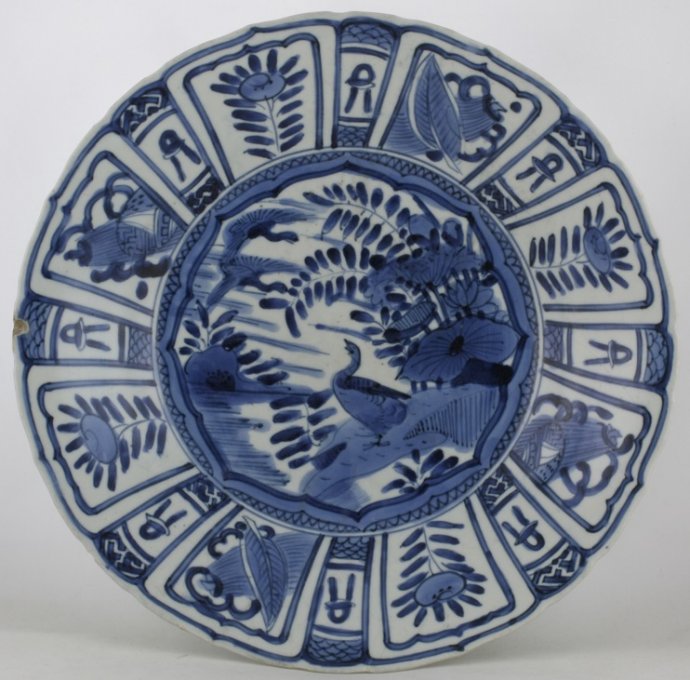
Sold Ceramics - Sold Japanese Blue and White wares 17th Century - Dishes - Page 1
Object 2012005
Dish
Japan
1670-1690
Height 62 mm (2.76 inch), diameter of rim 315 mm (15.43 inch), diameter of footring 147 mm (7.20 inch), weight 1.002 grams (35.35 ounce (oz.))
Dish on footring. Wide everted rim. On the base two spur-marks. Decorated in underglaze blue in Chinese kraak style with the ducks-in-a-pond motif. The sides and rim are divided into wide panels (fuyõ-de) filled with flowering plants alternating with auspicious symbols and separated from each other by narrow panels filled with ornamental tassels. The scheme of the reverse repeats that of the front large panels filled with a dot within a larger circle alternate with narrow panels with stylised lingzhi. Marked on the base with a square fuku (good luck) mark in running script, underglaze blue.
This dish presents a simplified version of the type design found on the kraak porselein dishes that were exported in such numbers to the West from China earlier in the century. The Dutch had turned to the Japanese kilns when this trade collapsed, following the fall of the Ming dynasty in 1644. It is intriguing to see the liberties taken with these now out-of-date designs. (Ayers, Impey & Mallet 1990, p.101)
For a similarly decorated dish, please see;
For a Chinese kraak dish that may have served as an example for the design, please see:
A square fuku (good luck) mark in running script, The mark was copied by the Japanese potters from Chinese porcelains of the late Ming period. (Impey, Jörg & Mason 2009, pp.74-75)
For other identical examples of the fuku (good luck) base mark in underglaze blue, please see:
- The Shibata Collection Part II, (The Kyushu Ceramic Museum, Kyushu, 1991), p.84, cat. 16.
- Dragons, Tigers and Bamboo: Japanese Porcelain and its impact in Europe - The Mac-Donald Collection, (O.Impey, C.J.A. Jörg and C. Mason, Douglas & McIntyre Publishers Inc., Vancouver/Toronto/Berkeley 2009), pp.74-75, Fig. 23 & p.193.
Condition: Two chips and various restored (re-stuck) pieces to the rim.
References:
Impey, Jörg & Mason 2009, pp.74-75, Fig. 23 & p.193
Price: Sold.

Sold Ceramics - Sold Japanese Blue and White wares 17th Century - Dishes - Page 1
Object 2010522
Dish
Japan, Arita presumably Sarugawa
1670-1690
Height 30 mm (1.18 inch), diameter of rim 220 mm (8.66 inch), diameter of footring 119 mm (4.69 inch), weight 318 grams (11.22 ounce (oz.))
Dish on footring, flat rim. On the base four spur-marks in a Y-pattern. Decorated in underglaze blue. The central design shows a river scene with a farmer leading two cows over a bridge surrounded by a scroll-border, characteristic of Chinese Transitional ware. The border design shows wide and narrow panels filled with Artemisia leaves and flowering stems. The reverse is divided into panels and sketchily painted.
The was design influenced by the decoration on Chinese T'ien-ch'i porcelain, which was exported to Japan. In 'Imari-Porzellan am Hofe der Kaiserin Maria Theresia' it is stated that the figure on the dish is most likely to be Tai Gongwang (Jiang Ziya), a politician at the beginning of the Zhou-period (11th cent. - 221 BCE). He was spotted when fishing in the river Weisui by the ruler Wen Wang, Tai Gongwang later became his teacher, he also served Wen Wang’s son Wu Wang the first emperor of the Zhou dynasty (r.1122-1115 BC). According to this legend a decoration of a man fishing is most likely to be Tai Gongwang. On this dish the Japanese artist used a theme that Chinese export wares in the early 17th century used. Jörg states that this is the best known type of Japanese porcelain imitating a specific Chinese group of dishes with a kraak body and a panelled border, but a Transitional decoration dating to 1635-1645. Japanese dishes of this design are not rare and were made in different sizes. A large example measuring 520 mm (20.47 inch), is in the Topkapi Saray Museum, Istanbul. (Düsseldorf 2000, p.45), (Jörg 2003/1, pp.28-29)
For similarly decorated dishes, please see;
- Japans porselein met blauwe decoraties uit de tweede helft van de zeventiende en de eerste helft van de achttiende eeuw, (D.F. Lunsingh Scheurleer, in, Mededelingenblad Nederlandse Vereniging van Vrienden van de Ceramiek, vols. 64/65, 1971), p.60, cat. 26.
- Mistrovská dĩla Japonského porcelánu / Masterpieces of Japanese Porcelain, (F. Suchomel, Prague 1997), pp.75-76, cat. 21.
- Imari-Porzellan am Hofe der Kaiserin Maria Theresia, exhibition catalogue (Hetjens-Museum, Düsseldorf, 2000), p.45, cat. 6.
- Fine & Curious: Japanese Export Porcelain in Dutch Collections, (C.J.A. Jörg, Hotei Publishing, Amsterdam, 2003), pp.28-29, cat. 8.
- Austrumu porcellans un Niderlande. Austrumu un Rietumu mijiedarbiba 17. gadsimta / Oriental Porcelain and the Netherlands. Interaction between East and West in the 17th century, (C.J.A. Jörg, Art Museum Riga Bourse, Riga, 2011), pp.158-159, cat. 47.
Condition: Perfect.
References:
Lunsingh Scheurleer 1971, cat. 26
Price: Sold.
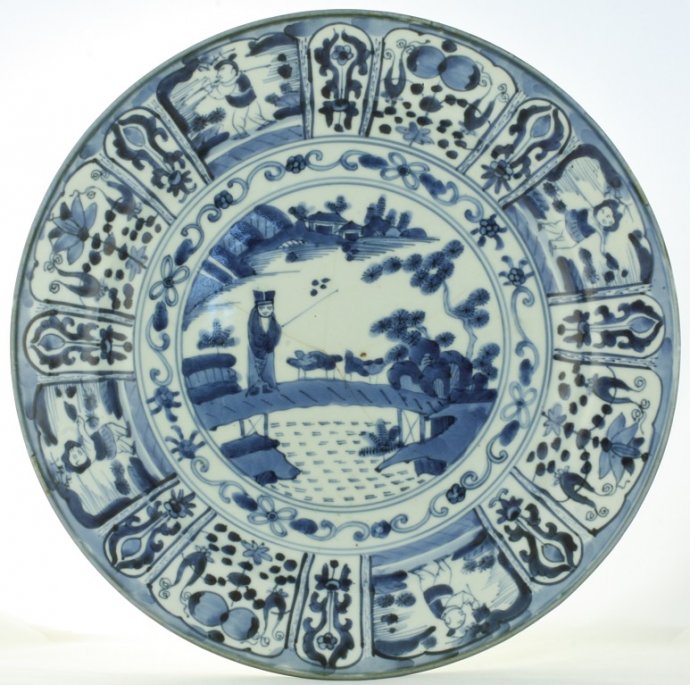
Sold Ceramics - Sold Japanese Blue and White wares 17th Century - Dishes - Page 1
Object 2011306
Dish
Japan, Arita presumably Sarugawa
1660-1680
Height 57 mm (2.24 inch), diameter of rim 353 mm (13.90 inch), diameter of footring 180 mm (7.09 inch)
Dish on footring, flat rim. On the base five spur-marks in a X-pattern. Decorated in underglaze blue. The central design shows a river scene with a farmer leading two cows over a bridge surrounded by a scroll-border characteristic of Chinese Transitional ware. The border design shows wide and narrow panels filled with single figures, 'tulip' motifs and stylised flowers. The reverse is divided into panels and sketchily painted.
The was design influenced by the decoration on Chinese T'ien-ch'i porcelain, which was exported to Japan. In 'Imari-Porzellan am Hofe der Kaiserin Maria Theresia' it is stated that the figure on the dish is most likely to be Tai Gongwang (Jiang Ziya), a politician at the beginning of the Zhou-period (11th cent. - 221 BCE). He was spotted when fishing in the river Weisui by the ruler Wen Wang, Tai Gongwang later became his teacher, he also served Wen Wang’s son Wu Wang the first emperor of the Zhou dynasty (r.1122-1115 BC). According to this legend a decoration of a man fishing is most likely to be Tai Gongwang. On this dish the Japanese artist used a theme that Chinese export wares in the early 17th century used. Jörg states that this is the best known type of Japanese porcelain imitating a specific Chinese group of dishes with a kraak body and a panelled border, but a Transitional decoration dating to 1635-1645. Japanese dishes of this design are not rare and were made in different sizes. A large example measuring 520 mm (20.47 inch), is in the Topkapi Saray Museum, Istanbul. (Düsseldorf 2000, p.45), (Jörg 2003/1, pp.28-29)
For identically decorated dishes, please see;
- Japans porselein met blauwe decoraties uit de tweede helft van de zeventiende en de eerste helft van de achttiende eeuw, (D.F. Lunsingh Scheurleer, in, Mededelingenblad Nederlandse Vereniging van Vrienden van de Ceramiek, vols. 64/65, 1971), p.60, cat. 26.
- Mistrovská dĩla Japonského porcelánu / Masterpieces of Japanese Porcelain, (F. Suchomel, Prague 1997), pp.75-76, cat. 21.
- Imari-Porzellan am Hofe der Kaiserin Maria Theresia, exhibition catalogue (Hetjens-Museum, Düsseldorf, 2000), p.45, cat. 6.
- Fine & Curious: Japanese Export Porcelain in Dutch Collections, (C.J.A. Jörg, Hotei Publishing, Amsterdam, 2003), pp.28-29, cat. 8.
- Austrumu porcellans un Niderlande. Austrumu un Rietumu mijiedarbiba 17. gadsimta / Oriental Porcelain and the Netherlands. Interaction between East and West in the 17th century, (C.J.A. Jörg, Art Museum Riga Bourse, Riga, 2011), pp.158-159, cat. 47.
Condition: A star-shaped hairline to the centre/base.
References:
Lunsingh Scheurleer 1971, cat. 26
Price: Sold.
More pictures of object 2010945, an identically shaped and decorated, sold dish >>
More pictures of object 2012389, an identically shaped and decorated, sold dish >>
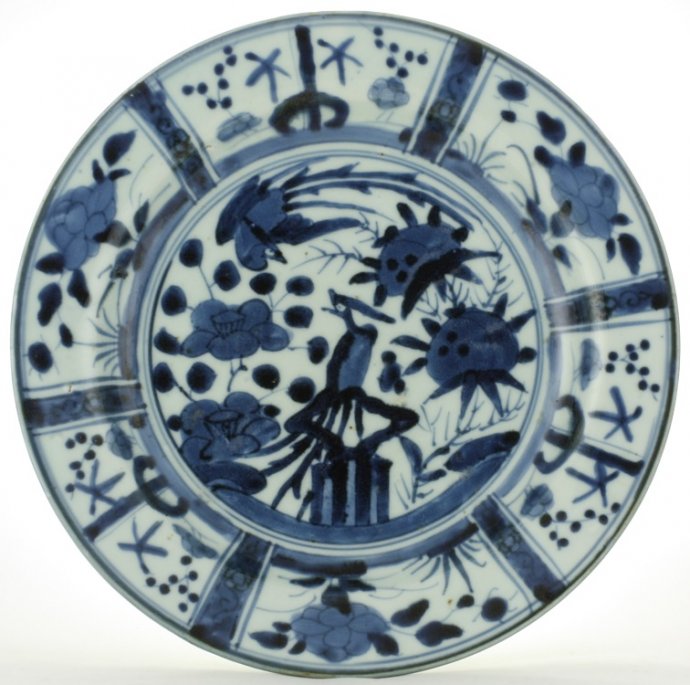
Sold Ceramics - Sold Japanese Blue and White wares 17th Century - Dishes - Page 1
Object 2011330
Dish
Japan
1660-1690
Height 53 mm (2.08 inch), diameter of rim 285 mm (11.22 inch), diameter of footring 134 mm (5.28 inch), weight 850 grams (29.98 ounce (oz.))
Dish on footring, flat rim. On the base four spur-marks in a Y-pattern. Decorated in underglaze blue with two hôô birds, one perched on pierced rockwork amongst fruiting peach and camellia, the other in flight above. The sides and rim in kraak style with six wide panels (fuyõ-de) filled with bamboo, peony and prunus, separated from each other by narrow panels filled with scrolls in blue on blue. The reverse is undecorated.
Dishes with this border design are also known with the VOC initials. They were probably ordered by the High Government from 1668 when it started to require porcelain for Batavia. An armorial decorated dish dated c.1667 has a similar border design and dates the style of the border. (Jörg 2003/1, pp.225-226 & p.230), (Antonin & Suebsman 2009, pp.224-225)
For identically decorated dishes, please see:
- Japans porselein met blauwe decoraties uit de tweede helft van de zeventiende en de eerste helft van de achttiende eeuw. (D.F. Lunsingh Scheurleer in Mededelingenblad Nederlandse Vereniging van Vrienden van de Ceramiek, vols. 64/65, 1971), p.57, cat. 19.
- Oriental Ceramics at the Cape of Good Hope 1652-1795. An account of the porcelain trade of the Dutch East India Company with particular reference to ceramics with the V.O.C. monogram, the Cape Market and South African Collections, (C.S. Woodward, Cape Town & Rotterdam, 1974), p.54, cat. 84.
- H.A. Daendels, Catalogus tentoonstelling Japans blauw wit Porselein. Op Hollandse bestelling en in de Japanse smaak, exhibition catalogue Gemeentelijk Museum Het Princessehof, Leeuwarden 1981. Also Published as Mededelingenblad Nederlandse Vereniging van Vrienden van de Ceramiek, vols. 101/102, p.41, cat. 25.
- Complete Catalogue of the Shibata Collection, (The Kyushu Ceramic Museum, Kyushu 2003), p.332, cat. 2495.
For other dishes with the same central design but with other sides and rim decorations, please see:
Condition: Perfect.
References:
Lunsingh Scheurleer 1971, cat. 19
Woodward 1974, cat. 84, 86 & 87
Jörg 2003/1, cat. 285, 286 & 291
Antonin & Suebsman 2009, cat. 91
Price: Sold.

Sold Ceramics - Sold Japanese Blue and White wares 17th Century - Dishes - Page 1
Object 2012161
Dish
Japan
1660-1690
Height 33 mm (1.30 inch), diameter of rim 216 mm (8.50 inch), diameter of footring 109 mm (4.29 inch), weight 413 grams (14.57 ounce (oz.))
Dish on footring, flat rim. Four spur-marks in a Y-pattern on the base. Decorated in underglaze blue with two Hoo-o birds, one perched on pierced rockwork amongst fruiting peach and camellia, the other in flight above. The sides and rim in kraak style with six wide panels (fuyõ-de) filled with bamboo, peony and prunus, separated from each other by narrow panels filled with scrolls in blue on blue. The reverse is undecorated.
Dishes with this border design are also known with the VOC initials. They were probably ordered by the High Government from 1668 when it started to require porcelain for Batavia. An armorial decorated dish dated c.1667 has a similar border design and dates the style of the border. (Jörg 2003/1, pp.225-226 & p.230), (Antonin & Suebsman 2009, pp.224-225)
For identically decorated dishes, please see:
- Japans porselein met blauwe decoraties uit de tweede helft van de zeventiende en de eerste helft van de achttiende eeuw. (D.F. Lunsingh Scheurleer in Mededelingenblad Nederlandse Vereniging van Vrienden van de Ceramiek, vols. 64/65, 1971), p.57, cat. 19.
- Oriental Ceramics at the Cape of Good Hope 1652-1795. An account of the porcelain trade of the Dutch East India Company with particular reference to ceramics with the V.O.C. monogram, the Cape Market and South African Collections, (C.S. Woodward, Cape Town & Rotterdam, 1974), p.54, cat. 84.
- H.A. Daendels, Catalogus tentoonstelling Japans blauw wit Porselein. Op Hollandse bestelling en in de Japanse smaak, exhibition catalogue Gemeentelijk Museum Het Princessehof, Leeuwarden 1981. Also Published as Mededelingenblad Nederlandse Vereniging van Vrienden van de Ceramiek, vols. 101/102, p.41, cat. 25.
- Complete Catalogue of the Shibata Collection, (The Kyushu Ceramic Museum, Kyushu 2003), p.332, cat. 2495.
For other dishes with the same central design but with other sides and rim decorations, please see:
Condition: Some fine crazing to the glaze and a firing flaw to the glaze in the centre.
References:
Lunsingh Scheurleer 1971, cat. 19
Woodward 1974, cat. 84, 86 & 87
Jörg 2003/1, cat. 285, 286 & 291
Antonin & Suebsman 2009, cat. 91
Price: Sold.

Sold Ceramics - Sold Japanese Blue and White wares 17th Century - Dishes - Page 1
Object 2012612
Dish
Japan
1670-1690
Height 60 mm (2.36 inch), diameter of rim 398 mm (15.67 inch), diameter of footring 192 mm (7.56 inch), weight 1,874 grams (66.10 ounce (oz.))
Dish on footring, wide flat rim. On the base five spur-marks in a X-pattern. Decorated in underglaze blue. The central design shows two pheasant, one perched on a rock amongst bamboo and the other in flight above. On the rim four large and widespread flower sprays (chrysanthemum, peony) and fruit sprays (pomegranate and Buddha's hand citron). On the reverse two stylised sprays. On the base four paper rectangular collectors' labels.
For an identically shaped, sized and decorated dish, in the collection of the British Museum, please see:
Condition: Perfect.
Reference:
Collection British Museum, Museum number: 1957,1029.1
Price: € 999 Currency Converter




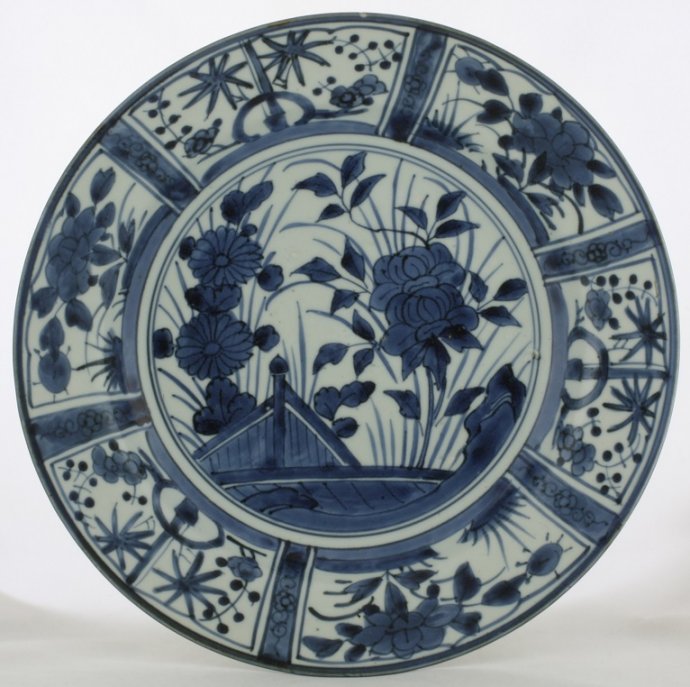
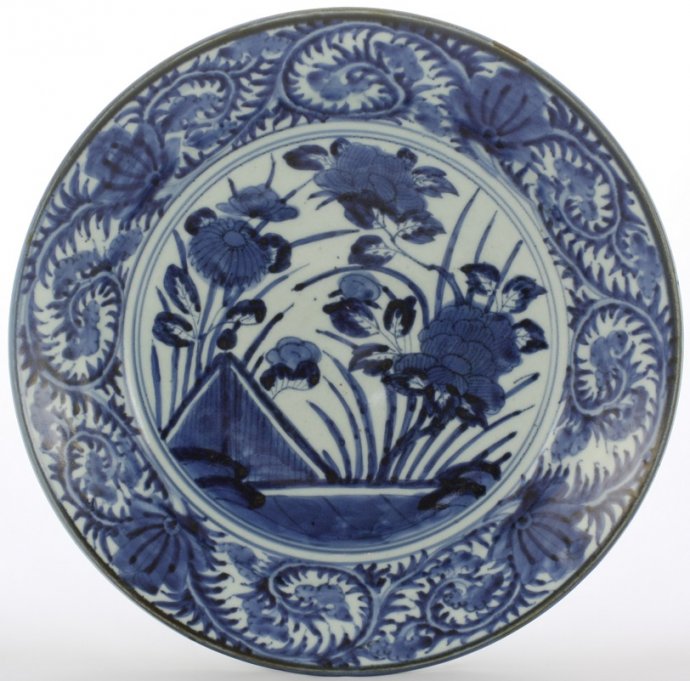


 create websites
create websites